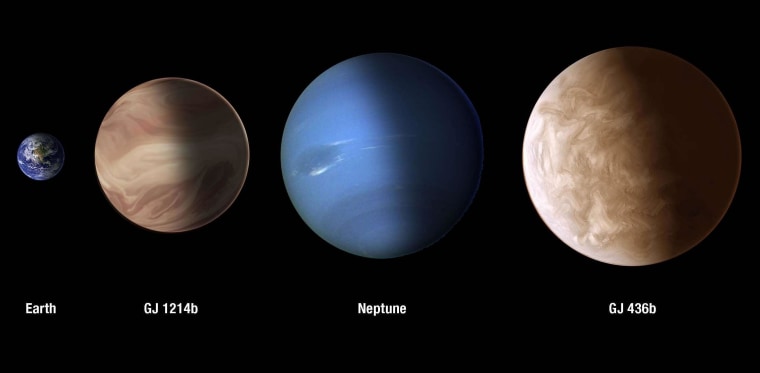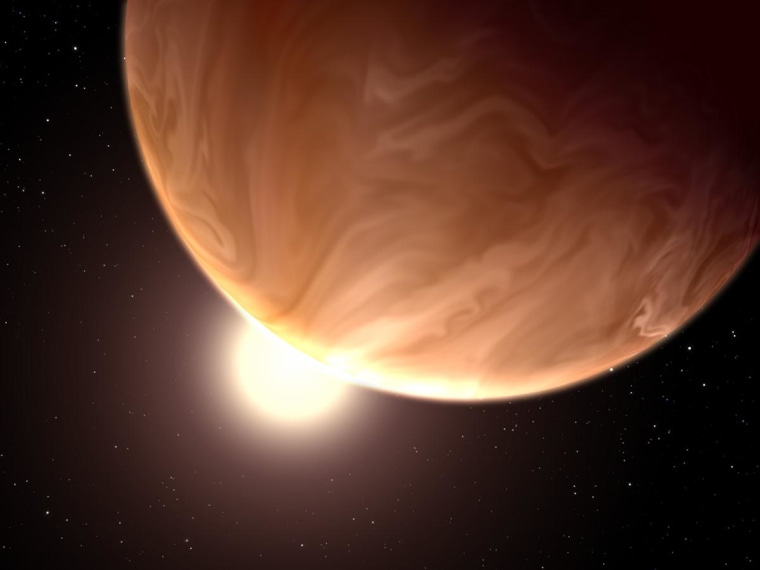Observations from the Hubble Space Telescope suggest that a super-Earth and a warm Neptune-sized planet far beyond our solar system are blanketed by high-altitude clouds.
Astronomers lay out their case for cloudiness in this week's issue of the journal Nature. This isn't the first time clouds have been detected around extrasolar planets, but it does extend the spectrum of atmospheric study to new classes of alien worlds.
"Both planets are telling us something about the diversity of planet types that occur outside of our own solar system; in this case we are discovering we may not know them as well as we thought," Caltech astronomer Heather Knutson, a leader of one of the Hubble research teams, said in a NASA news release. "We'd really like to determine the size at which these planets transition from looking like mini-gas giants to something more like a water world or a rocky, scaled-up version of the Earth. Both of these observations are fundamentally trying to answer that question."
Knutson and her colleagues focused on GJ 436b, the warm Neptune, which is 36 light-years away in the constellation Leo. They used Hubble to track the planet in fine detail as it passed in front of its parent star, and looked for the chemical fingerprint of starlight shining through the edge of its atmosphere. The interesting thing is that they saw no distinguishing fingerprint.
"Either this planet has a high cloud layer obscuring the view, or it has a cloud-free atmosphere that is deficient in hydrogen, which would make it very unlike Neptune," Knutson explained. "Instead of hydrogen, it could have relatively large amounts of heavier molecules such as water vapor, carbon monoxide, and carbon dioxide, which would compress the atmosphere and make it hard for us to detect any chemical signatures."

A different research team, led by Laura Kreidberg and Jacob Bean of the University of Chicago, focused on GJ 1214b, the super-Earth, which is 40 light-years from Earth in the constellation Ophiuchus. Previous observations produced a profile similar to GJ 436b: Spectral analysis showed that the atmosphere was dominated by water vapor or hydrogen, but there was no discernible difference between the bulk of the planet's disk and the edge of the atmospheric layer.
In this week's Nature paper, researchers say Hubble's near-infrared observations show conclusively that GJ 1214b is blanketed by high clouds that hide the super-Earth's lower atmosphere and surface. They ruled out the possibility that the atmosphere was cloud-free.
The researchers say GJ 1214b's clouds would probably be unlike Earth's, due to big differences in atmospheric temperature and pressure. They suggest that the clouds could contain zinc sulfide or potassium chloride, or perhaps the kinds of hydrocarbons found in the murky haze that surrounds Titan, a mysterious moon of Saturn.
More about extrasolar planets:
- Alien planet count passes the 1,000 mark
- Astronomers analyze alien world's atmosphere
- NBC News archive on exoplanets
In addition to Knudson, the authors of "A Featureless Transmission Spectrum for the Neptune-Mass Exoplanet GJ 436b" include Bjorn Benneke, Drake Deming and Derek Homeier.
In addition to Kreidberg and Bean, the authors of "Clouds in the Atmosphere of the Super-Earth Exoplanet GJ 1214b" include Jean-Michel Desert, Bjorn Benneke, Drake Deming, Kevin Stevenson, Sara Seager, Zachory Berta Thompson, Andreas Seifahrt and Derek Homeier.
